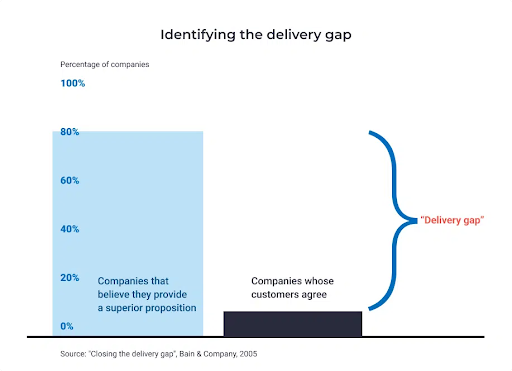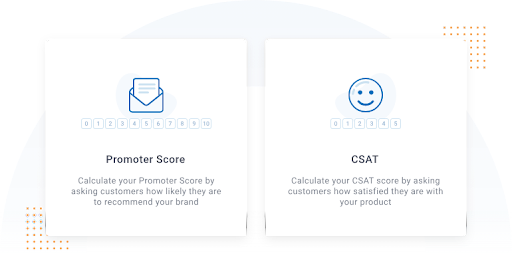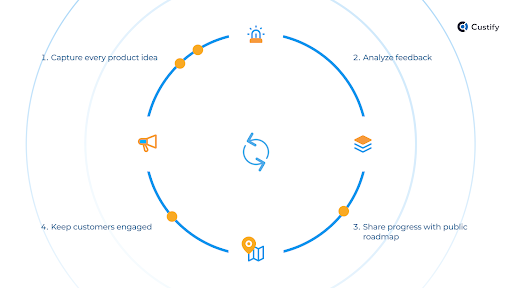Customer feedback has become a valuable asset for companies seeking to improve their products, services, and overall customer experience. One key department responsible for harnessing the power of customer feedback is Customer Success, as the team plays a pivotal role in managing customer feedback to drive product enhancements, refine processes, and foster strong customer relationships. This article explores the importance of customer feedback for Customer Success and delves into strategies for effectively managing this feedback to achieve long-term success.
How Can Your Customer Success Team Best Manage Customer Feedback?
1. Go beyond simple customer support
A study on quiet quitting revealed that “over 56% of CS/CX personnel state that customer support is part of their general responsibilities.”
However, the role of Customer Success (CS) has evolved far beyond traditional customer support. While Customer Support primarily focuses on issue resolution and addressing immediate concerns, Customer Success takes a proactive approach to ensure long-term customer satisfaction, loyalty, and business growth.
One integral aspect of this evolving role is managing customer feedback not to supplant support but to enrich it. By actively collecting, analyzing, and acting upon feedback, CS teams can collaborate with other departments to deliver tangible results, preemptively address issues, and create upselling opportunities that drive both customer satisfaction and business growth. This dynamic approach to feedback management solidifies the role of Customer Success as a key driver of holistic customer satisfaction and organizational success.
2. Launch a Voice of the Customer initiative
By embracing Voice of the Customer (VoC) initiatives, organizations welcome direct customer input. While most businesses gather and act upon client feedback, VoC programs take this a step further by facilitating direct improvements to the product.

Launching a Voice of Customer (VoC) program involves careful planning and execution to gather valuable customer insights. Here’s a short guide on how to successfully launch a VoC program:
- Set Clear Objectives: Define the specific goals of your VoC program. Whether improving products, enhancing customer experience, or identifying pain points, clear objectives guide your efforts.
- Define Your Target Audience: Identify the segment of customers you want to gather feedback from. Consider factors like demographics, usage patterns, and customer lifecycle stages
- Select Your Feedback Channels: Choose the channels through which you’ll collect feedback. These include surveys, emails, website feedback forms, social media, and customer support interactions.
- Design Feedback Mechanisms: Develop well-structured surveys and questionnaires that align with your objectives. Craft questions that gather actionable insights and provide a mix of quantitative and qualitative data.
- Choose Timing and Frequency: Determine when and how often you’ll collect feedback. This could be after specific interactions, at key touchpoints, or periodically.
- Implement Data Collection: Deploy the selected feedback mechanisms across your channels. Utilize technology to automate the process and ensure consistency.
- Analyze Feedback: Collect the gathered data and employ analytical tools to extract meaningful insights. Identify trends, patterns, and recurring issues within the feedback.
- Prioritize Action Items: Based on the insights, prioritize areas that require immediate attention or improvements. Consider the impact of changes on customer satisfaction and business goals.
- Create Action Plans: Develop action plans for each priority area. Assign responsibilities, set timelines, and outline the steps to address the identified issues.
- Implement Changes: Execute the action plans, making necessary adjustments to products, services, or processes based on customer feedback.
- Communicate Changes: Inform your customers about the changes you’ve made due to their feedback. This not only demonstrates your commitment to their opinions but also fosters transparency.
- Monitor Progress: Continuously monitor the impact of your changes. Track key performance indicators (KPIs) related to customer satisfaction and assess the effectiveness of your actions.
- Iterate and Improve: Regularly review and refine your VoC program based on feedback and results. Keep evolving your strategies to align with changing customer needs.
- Gather Feedback on the VoC Program: Seek feedback from internal teams and stakeholders involved in the program to improve its processes and outcomes.
Launching a VoC program is a dynamic process that requires ongoing commitment. By actively listening to your customers, making data-driven improvements, and consistently iterating your approach, you’ll create a customer-centric culture that drives success and customer loyalty.
3. Conduct extensive research and surveys
Conducting extensive research and surveys is a crucial approach for effectively gathering and managing customer feedback, as structured and quantifiable insights are instrumental in understanding customer sentiments, preferences, and needs. Surveys, in particular, emerge as a powerful tool in this process due to their ability to efficiently collect data from a broad customer base, facilitate organized analysis, and drive informed decision-making.

You can also take customer feedback a step further by conducting RATER surveys that break down customers’ potential concerns according to the five key dimensions of the model (keep in mind that this type of survey is best suited for your most engaged customers or users):
- Reliability: Incorporate questions that evaluate customers’ perceptions of the consistency and dependability of your service. Ask about issues related to service interruptions, delays, and accuracy. For instance:
“How often have you experienced delays in our service delivery?”
“Have you encountered any instances of errors or inconsistencies in our service?”
- Assurance: Craft questions that gauge customers’ feelings of security, trust, and confidence in your service. Inquire about the professionalism and expertise of your staff and how well your service meets their expectations. For instance:
“Do you feel confident in the knowledge and abilities of our customer support team?”
“To what extent do you trust our service to meet your needs?”
- Tangibles: Design questions that explore the physical aspects of your service, such as the appearance of your communication materials. Probe into any concerns related to the visual presentation of your brand. For instance:
“Do you find our website and communication materials user-friendly?”
- Empathy: Include questions that assess how well your staff demonstrates caring, understanding, and attentiveness towards customer needs. Seek feedback on the personalized nature of interactions and whether customers feel valued. For instance:
“Did our customer service representatives show genuine concern for your issues?”
“How well did our team understand your specific needs and circumstances?”
- Responsiveness: Incorporate questions that delve into customers’ perceptions of how promptly and effectively your service addresses their inquiries, requests, and concerns. Explore any frustrations related to waiting times and timely issue resolution. For instance:
“Were you satisfied with the speed at which we resolved your recent inquiry?”
“Did you feel that our team addressed your concerns in a timely manner?”
4. Create a model for customer feedback management (CFM)
A Customer Feedback Management (CFM) model holds significant importance as it offers a structured framework for businesses to systematically collect, analyze, and leverage customer feedback. By centralizing customer opinions, needs, and concerns, the CFM model enables informed decision-making, identifies trends, and proactively addresses issues. It guides product and service enhancements, measures customer satisfaction, fosters loyalty, and establishes a competitive edge.

Creating a comprehensive model for Customer Feedback Management involves several steps that ensure a structured approach to collecting, analyzing, and acting on customer feedback. Here’s a step-by-step guide to help you establish an effective CFM model:
a. Define Objectives Clearly outline the goals of your CFM model. Determine what you aim to achieve through customer feedback – whether it’s product improvement, enhancing customer experience, or identifying trends.
b. Identify Feedback Channels List the various channels through which customers can provide feedback. This includes surveys, feedback forms, customer support interactions, social media, reviews, and more.
c. Design a Feedback Collection Process Create a systematic process for collecting feedback from different channels. Define how feedback will be captured, stored, and categorized. Automate this process as much as possible to streamline data collection. Here’s a quick example for SaaS products.
d. Categorize Feedback Create categories or themes to classify the feedback you receive. This helps in organizing and analyzing feedback effectively. Common categories could include product features, usability, customer service, pricing, and more.
e. Choose Feedback Analysis Tools Select tools that assist in analyzing feedback data. These can include sentiment analysis tools, text analytics software, and data visualization platforms. These tools help extract insights from large volumes of feedback.
f. Establish Feedback Review Team Form a dedicated team responsible for reviewing and analyzing feedback. This team could consist of representatives from customer support, product development, marketing, and other relevant departments.
g. Prioritize Feedback Develop a method to prioritize feedback based on factors such as the frequency of the issue, its impact on customers, and alignment with business objectives.
h. Take Action Translate feedback into actionable steps. Assign responsibilities for addressing specific issues to relevant teams. Regularly update the status of each issue to ensure progress is tracked.
i. Implement Improvements Leverage the insights gained from feedback to make necessary improvements to products, services, and customer experiences.
j. Monitor and Iterate Continuously monitor the impact of changes made based on customer feedback. Iterate the CFM model based on results and evolving customer needs.
k. Close the Loop with Customers Communicate with customers to let them know how their feedback has led to improvements. This reinforces their sense of value and involvement in the process.
l. Gather Feedback on the CFM Process Don’t forget to gather feedback from your internal teams involved in the CFM process. This helps refine the model over time.
m. Training and Awareness Ensure that all employees are aware of the CFM model, its importance, and their roles in contributing to the process.
n. Continuous Improvement: Regularly review and update your CFM model to align with industry best practices and evolving customer expectations.
Creating a model for Customer Feedback Management involves a combination of strategy, technology, and organizational collaboration. By systematically collecting, analyzing, and acting upon customer feedback, CS teams can help enhance their companies’ offerings, build stronger customer relationships, and drive overall growth.
5. Use an extensive toolset for your support interactions
Selecting the right toolset for support interactions is a crucial decision that directly impacts your business’s quality of customer service. Here’s a step-by-step guide to help you choose the best toolset for your support interactions:
1. Assess Your Needs: Understand your support requirements. Identify the types of interactions you’ll handle, the channels you’ll use (email, live chat, phone, social media), and the level of automation you need.
2. Define Your Goals: Clarify your objectives for customer support. Are you aiming to improve response times, enhance customer satisfaction, or streamline ticket management? Clearly defined goals will guide your toolset selection.
3. Research Available Tools: Explore the market for customer support tools. Look for helpdesk software (ex.: Zendesk, Freshdesk), live chat platforms (ex.: Intercom, LiveChat), knowledge base systems (ex.: HelpJuice, Confluence), and analytics tools (ex.: Mixpanel, Amplitude). Also, consider user feedback.
4. Scalability and Flexibility: Choose tools that can scale with your business growth. Ensure they offer flexibility to accommodate changing needs and emerging communication channels.
5. Integration Capabilities: Prioritize tools that integrate well with your existing systems, such as CRM, marketing automation, and e-commerce platforms. Integration enhances data flow and provides a holistic view of customer interactions.
6. User-Friendly Interface: Opt for tools that have an intuitive interface and are easy for your support team to use. A user-friendly design reduces training time and boosts efficiency.
7. Customization Options: Look for tools that allow customization to match your brand’s look and feel. Customizable templates, branding options, and chat widgets create a consistent customer experience.
8. Multichannel Support: Choose a toolset that offers support across various channels, enabling customers to reach you through their preferred method. Ensure it supports both traditional channels and emerging platforms.
9. Analytics and Reporting: Prioritize tools that provide detailed analytics and reporting. Insights into response times, resolution rates, and customer satisfaction help you optimize your support strategies.
10. Automation and AI: Consider tools that offer automation and AI features. These can include automated ticket routing, chatbots, and predictive analytics, which enhance efficiency and provide proactive support.
11. Security and Compliance: Ensure the toolset adheres to security protocols and compliance standards, especially if handling sensitive customer data. Look for features like data encryption and GDPR compliance.
12. Customer Feedback Integration: Opt for tools that seamlessly integrate customer feedback collection. This helps you gather customer insights directly and aligns with your Voice of Customer initiatives.
By following these steps, you’ll be better equipped to select a toolset for support interactions that align with your business goals, enhance customer satisfaction, and empower your support team to deliver exceptional service.
6. Promote data governance for accurate customer support results
To ensure the integrity of your Customer Feedback Management (CFM) process, it’s imperative to support feedback with robust data that is well-grounded and validated. This practice not only enhances the health of your CFM but also strengthens your strategies for the future.
Data hygiene forms the cornerstone of a reliable CFM. It involves maintaining accurate, consistent, and up-to-date customer information. By cleansing and standardizing data, you reduce the risk of erroneous feedback infiltrating your analysis. Dirty data, tainted by duplicates, outdated records, or inaccuracies, can skew the interpretation of customer feedback, leading to misguided actions and suboptimal results.
To counter this, implement stringent data hygiene practices, employing automated tools for data cleansing, validation, and deduplication. By establishing a clean data foundation, you fortify your CFM against the potential pitfalls of unverified feedback.
Equally crucial is data governance, a framework that ensures data quality, security, and compliance throughout its lifecycle. Data governance establishes protocols for collecting, managing, and storing customer data, safeguarding its accuracy and reliability.
By implementing data governance policies, you create a structured framework to verify and validate customer feedback against factual data points. This practice transforms customer feedback from anecdotal observations into substantiated insights, thus enhancing the credibility and value of your CFM.
When customer feedback is anchored in verified data, it gains a level of authenticity that empowers decision-makers. Data-backed insights offer a comprehensive understanding of customer sentiments, preferences, and behaviors. This level of granularity enables businesses to spot trends, make precise predictions, and implement impactful changes.
Summing Up
In the realm of Customer Success, managing customer feedback is a strategic process that can drive significant improvements in product quality, customer relationships, and overall business success.
By leveraging customer feedback effectively, companies can not only address immediate concerns but also foster an environment of continuous improvement and innovation. Customer Success teams that prioritize feedback collection, analysis, and action are well-positioned to create lasting customer loyalty and gain a competitive edge in today’s dynamic market.
